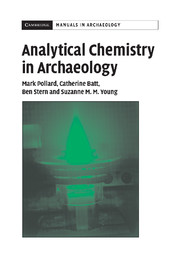Book contents
- Frontmatter
- Contents
- List of figures
- List of tables
- Preface
- PART I THE ROLE OF ANALYTICAL CHEMISTRY IN ARCHAEOLOGY
- PART II THE APPLICATION OF ANALYTICAL CHEMISTRY TO ARCHAEOLOGY
- PART III SOME BASIC CHEMISTRY FOR ARCHAEOLOGISTS
- 10 ATOMS, ISOTOPES, ELECTRON ORBITALS, AND THE PERIODIC TABLE
- 11 VALENCY, BONDING, AND MOLECULES
- 12 THE ELECTROMAGNETIC SPECTRUM
- 13 PRACTICAL ISSUES IN ANALYTICAL CHEMISTRY
- Epilogue
- Appendices
- References
- Index
13 - PRACTICAL ISSUES IN ANALYTICAL CHEMISTRY
Published online by Cambridge University Press: 03 May 2010
- Frontmatter
- Contents
- List of figures
- List of tables
- Preface
- PART I THE ROLE OF ANALYTICAL CHEMISTRY IN ARCHAEOLOGY
- PART II THE APPLICATION OF ANALYTICAL CHEMISTRY TO ARCHAEOLOGY
- PART III SOME BASIC CHEMISTRY FOR ARCHAEOLOGISTS
- 10 ATOMS, ISOTOPES, ELECTRON ORBITALS, AND THE PERIODIC TABLE
- 11 VALENCY, BONDING, AND MOLECULES
- 12 THE ELECTROMAGNETIC SPECTRUM
- 13 PRACTICAL ISSUES IN ANALYTICAL CHEMISTRY
- Epilogue
- Appendices
- References
- Index
Summary
Producing a good chemical analysis, particularly of difficult materials such as those often encountered in archaeology, is as much an art as a science. It requires experience, ingenuity, perseverance, and, often, luck. There are, however, a number of steps which can be taken to minimize the dependence on the element of luck. These include well-thought-out and appropriate sampling procedures, high quality standards matched to the material being analyzed, a rigorous approach to calibration, and, above all, a laboratory dedicated to good quality assurance procedures. Here we outline some of the procedures used for the preparation of solutions for inorganic trace element and organic residue analysis, and give a series of basic “recipes”. A more comprehensive treatment can be found in Mester and Sturgeon (2003). We then discuss in detail the types of analytical standards used to calibrate analytical instruments (synthetic, primary, secondary, and internal). The meaning of the terms accuracy and precision is explained, together with some mathematical procedures for calculating the errors associated with the analysis, particularly those arising from linear regression, which is almost invariably used to quantify analytical data. The classic work on quantifying errors of measurement is Topping (1972), and Barford (1985) and Miller and Miller (1993) present much of the basic mathematics necessary to deal with the statistical side of analytical chemistry. The last section discusses appropriate overall quality assurance procedures – essential to ensure (and demonstrate) that the analytical data are fit for purpose.
- Type
- Chapter
- Information
- Analytical Chemistry in Archaeology , pp. 294 - 321Publisher: Cambridge University PressPrint publication year: 2007

